Introduction
The new reference material for Thermal ConductivityThermal conductivity (λ with the unit W/(m•K)) describes the transport of energy – in the form of heat – through a body of mass as the result of a temperature gradient (see fig. 1). According to the second law of thermodynamics, heat always flows in the direction of the lower temperature.thermal conductivity, ERM-FC440, is the successor to the well-known IRMM- 440 reference material, which is no longer available. ERM-FC440 was certified by the Institute of European Reference Materials, ERM®, located in Belgium [1]. The material is intended for quality control and assessment of the method performance of guarded hot plate (GHP) measurements as well as for calibration of heat flow meter (HFM) instruments [2].
Properties of ERM-FC440
ERM-FC440 resin-bonded glass fiber boards are available in three different sizes:
- 30 cm x 30 cm (ERM-FC440a)
- 50 cm x 50 cm (ERM-FC440b)
- 60 cm x 60 cm (ERM-FC440c)
The mean thickness of ERM-FC440 is (28.65 ± 0.15) mm under a load of 0.25 kPa and (28.27 ± 0.19) mm under a load of 1.5 kPa. The densities of all ERM-FC440 samples are in the range of 130 and 148 kg/m3 [2]. The thickness and density of each individual sample plate at 0.25 kPa are stated on each reference material certificate. ERM-FC440 is certified for its Thermal ConductivityThermal conductivity (λ with the unit W/(m•K)) describes the transport of energy – in the form of heat – through a body of mass as the result of a temperature gradient (see fig. 1). According to the second law of thermodynamics, heat always flows in the direction of the lower temperature.thermal conductivity in the temperature range from -10°C to 70°C [2]. In addition, indicative Thermal ConductivityThermal conductivity (λ with the unit W/(m•K)) describes the transport of energy – in the form of heat – through a body of mass as the result of a temperature gradient (see fig. 1). According to the second law of thermodynamics, heat always flows in the direction of the lower temperature.thermal conductivity values are given in the range from -150°C to -10°C. The temperature-dependent Thermal ConductivityThermal conductivity (λ with the unit W/(m•K)) describes the transport of energy – in the form of heat – through a body of mass as the result of a temperature gradient (see fig. 1). According to the second law of thermodynamics, heat always flows in the direction of the lower temperature.thermal conductivity λ of ERM-FC440, as stated in the certificate, is expressed as
λ [W/(m·K)] = 0.03104 + 1.1 · 10-4 · T [°C] (1)
for the entire temperature range from -150°C to 70°C.
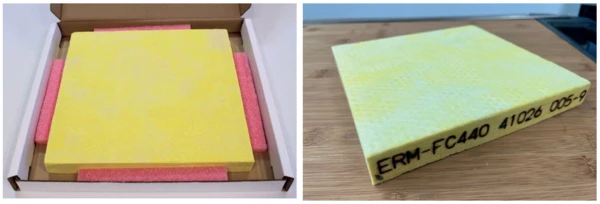
The expanded uncertainty is 1.1 % in the range from -10°C to 70°C and 1.9% to 1.1% in the range from -150°C to -10°C. Figure 2 displays the nominal Thermal ConductivityThermal conductivity (λ with the unit W/(m•K)) describes the transport of energy – in the form of heat – through a body of mass as the result of a temperature gradient (see fig. 1). According to the second law of thermodynamics, heat always flows in the direction of the lower temperature.thermal conductivity λ of ERM-FC440 according to equation 1 as well as the uncertainty budget.
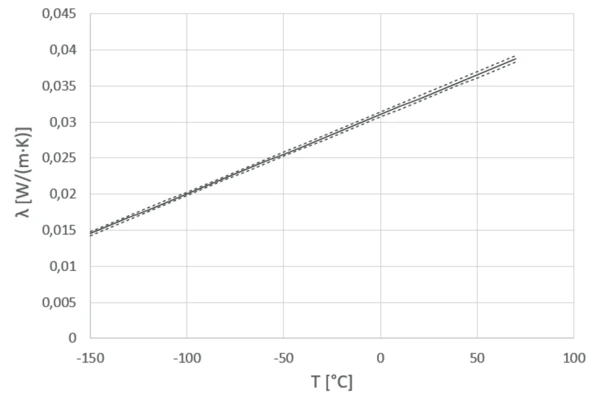
Thermal Conductivity Results
1. Results Obtained with the GHP 456
The guarded hot plate (GHP) technique is an absolute method without any calibration of the Thermal ConductivityThermal conductivity (λ with the unit W/(m•K)) describes the transport of energy – in the form of heat – through a body of mass as the result of a temperature gradient (see fig. 1). According to the second law of thermodynamics, heat always flows in the direction of the lower temperature.thermal conductivity. In the two-plate mode, the Thermal ConductivityThermal conductivity (λ with the unit W/(m•K)) describes the transport of energy – in the form of heat – through a body of mass as the result of a temperature gradient (see fig. 1). According to the second law of thermodynamics, heat always flows in the direction of the lower temperature.thermal conductivity λ is calculated from the power Q flowing into the hot plate with metering area A, the temperature gradient across the two samples ΔT as well as the mean sample thickness d as follows:

GHP measurements on ERM-FC440 samples were carried out using a NETZSCH GHP 456 HT Titan® equipped with liquid nitrogen cooling. ERM-FC440a specimens with serial numbers 001, 002, 003, and 005 were used for the GHP tests. The pair of specimens 001+002 and the pair 003+005 were each measured simultaneously in the two-plate mode. The temperature gradient across the samples was 30 K at temperatures below -10°C, and 20 K at 10°C and higher temperatures. The specimens had rigid spacers in their corners with a length identical to the nominal sample thickness in order to ensure a defined sample thickness.
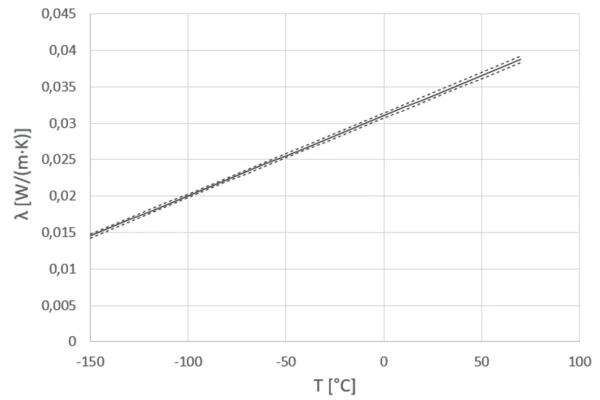
Figure 3 depicts the GHP measurement results: In the temperature range between -150°C and 70°C, the relative deviation from the nominal Thermal ConductivityThermal conductivity (λ with the unit W/(m•K)) describes the transport of energy – in the form of heat – through a body of mass as the result of a temperature gradient (see fig. 1). According to the second law of thermodynamics, heat always flows in the direction of the lower temperature.thermal conductivity values calculated from equation 1 is less than ± 1.3% for all measurement data except for one point at -150°C which deviates by -2.2%. These results are in accordance with the expected accuracy of the GHP 456.

2. Results Obtained with the HFM 446
The heat flow meter (HFM) technique is a relative method based on calibration of the heat-flux sensors using a reference material with known thermal conductivity. The unknown thermal conductivity λ of a sample is calculated from the heat flux per area Q/A and the temperature gradient ΔT across the sample with mean thickness d according to the Fourier‘s equation for onedimensional heat flow as follows:

The HFM measurements on the ERM-FC440 samples were carried out using the NETZSCH HFM 446 Lambda Eco-Line Small, Medium and Large instruments. Two HFM 446 Large devices with serial numbers 0009 and 0010 at different locations were used to test the ERM-FC440c specimens with serial numbers 004 and 005. Two HFM 446 Medium devices with serial number 0007 and 0009 were used to test the ERM-FC440a specimens with serial numbers 001, 002, 003 and 005. Three HFM 446 Small devices with serial numbers 0086, 0087 and SOA-002 were used to test ERM-FC440 specimens with the size 20 cm x 20 cm cut out of the ERM-FC440c board with serial number 005 after the measurements in the HFM 446 Large were completed. For documentation purposes, each 20-cm board was assigned an identification number with five digits, which was lasered on the front face (see also figure 1 on the right). All devices were calibrated with either NIST SRM 1450d or IRMM440. The measurements were performed at mean temperatures between -10°C and 70°C with a temperature gradient across the samples of 20 K and a contact pressure of maximum 2 kPa.

Figures 4 to 6 depict the measurement results from all HFM instruments. Across the entire temperature range, the relative deviation from the nominal thermal conductivity values calculated using equation 1 is within ± 1.5% for most measurement results, except for some measurement points at the highest temperature of 70°C. All results are in accordance with the expected accuracy of ± 2% for the HFM 446 heat flow meters.
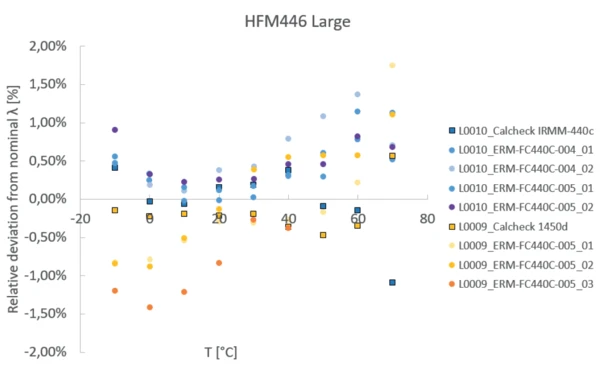

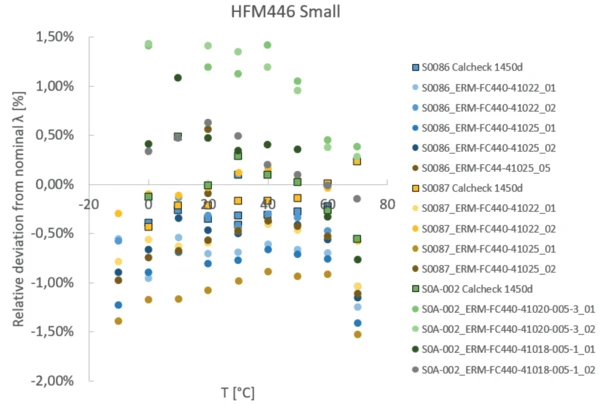
Summary
The thermal conductivity of the new reference material for thermal conductivity, ERM-FC440, was investigated in the temperature range between -150°C and 70°C applying one GHP 456 and several HFM 446 devices. Almost all results were in agreement within ± 1.5% with the nominal values, reflecting the accuracy of GHP 456 Titan® and HFM 446 Lambda instruments by NETZSCH.